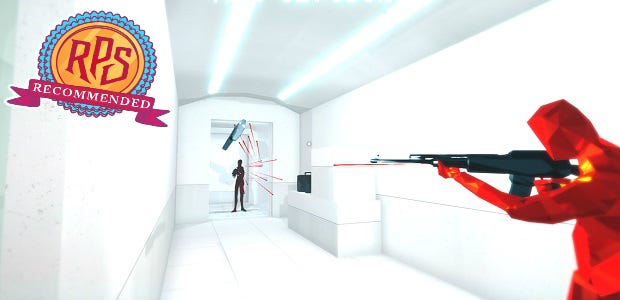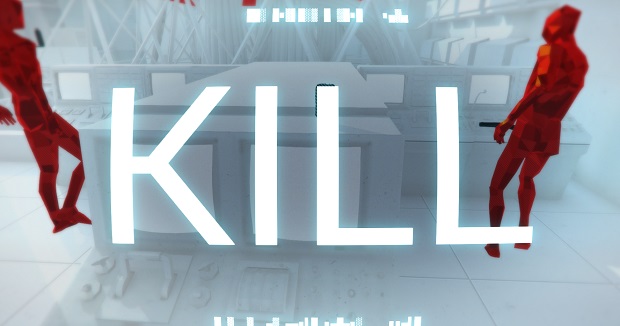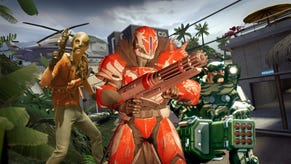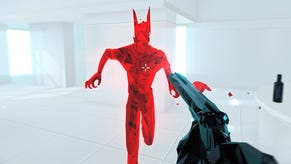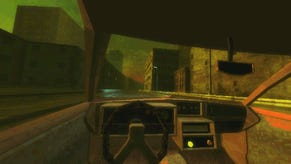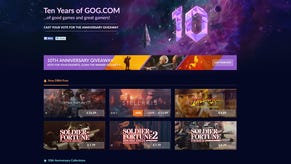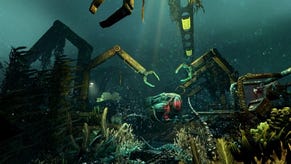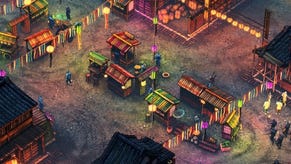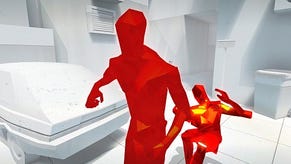Wot I Think: SUPERHOT
Time to die
All I really wanted from the full, commercial release of SUPERHOT [official site] was more of the same. The original prototype ranks among my favourite FPS games of recent years, its 'time only moves when you move' idea causing it to play out like a turn-based Hotline Miami, viewed from a fresh perspective. Can that central idea carry an entire game, however, or would it become stretched thin? Here's wot I think.
There are several similarities to Cactus' kill 'em up, including the necessity to throw spent firearms at enemies, the use of improvised melee weaponry and the fact that a single hit will stop you in your tracks. And then there's the style of the game, which is drawn from a completely different palette to Hotline's grotesqueries, grime and gore, but is equally important. There is substance to go with the style, but both game's stand out from the crowd thanks to their finely executed aesthetics.
In SUPERHOT, enemies seem to be made of glass, their bodies shattering at the point of impact, leading to strangely beautiful moments as a limb explodes into fragments or the stained red structure of a silica skull collapses as a body crumples and disintegrates. The sound effects match the visuals and even though I was tempted to write a strongly worded letter of disagreement to Nick Lowe by the time I'd heard my own body breaking for the hundredth time, I haven't grown tired of the splintering sounds of my targets.
It's ultraviolence without any of the splatter or screams.
I'd also expected ultraviolence without any context and that's certainly how the game sets out its stall. You're in an office building, killing angry people, and then you're in a bar, and then you're in a...cage?
It's not long before things start to drift toward the deep end of the pool, where strange things lurk beneath the surface. In fact, the game is drawn toward weird waters from the opening moments, when a framing device reminiscent of Pony Island introduces SUPERHOT as a game within a game – the latter game being a fake, glitchy operating system that acts as a menu screen.
From there you can jump straight into the story or explore some submenus, which contain the other programs on this fake OS. They're eerily convincing fragments of an alternate reality in which SUPERHOT is the hot new thing, a game that looks far ahead of whatever fictional time it exists in, given the crude nature of its neighbours.
The story, such as it is, mainly unfolds during instant messenger dialogues between the character you play and the friend who first drops a cracked version of SUPER HOT onto your hard drive. There are chuckles about the disconnected nature of the levels and the apparent lack of a plot and, a few levels in, something sinister breaks into the conversation and the game within a game is revealed to be something far more mysterious than a turn-based FPS.
I was thoroughly entertained during the couple of hours that the story lasted. It's brief, yes, but it's packed with ideas, both in the plotting which is alternately creepy and humorously self-aware, and in terms of level design and modifications to your toolset. There's only one major change, one addition to the control scheme beyond the time-tampering, but it's an extremely smart development, vastly increasing the possibility for slick play without overcomplicating the game's essential simplicity. Kill or be killed is the only rule but by providing both temporal and spatial controls, SUPER HOT encourages the kind of inventive action that more traditional FPS games rarely capture outside scripted sequences.
If I have one notable complaint about the story mode, beyond its brevity (which, given the quality of the other modes, might actually be a virtue; it doesn't overstay its welcome), it is that some scenes are a little too scripted. Like the Hotline Miami 2 levels that felt like punishing puzzles that required trial and error rather than creative play and speedy reflexes, some situations are designed to require an immediate and precise response. Of course, 'immediate' is relative because you decide when the next moment actually arrives, but when a level begins with several guns primed to fire and pointed at your face, you need to plan that moment with foresight that is actually the hindsight gained in the life you just lost.
It's a minor complaint. SUPERHOT actually suits those scenarios, even if I don't find them as satisfying as the more free-form and chaotic fights, and they're not overused. Nothing is overused in the story, short as it is, and if that were all the game contained, it'd be much tougher to recommend. As it is, I can recommend the game to anyone who finds the idea of the central mechanic interesting.
Do you want to freeze as a bullet whistles past your ear and see that bullet hang stationary, a trail like a scar in the air behind it? Do you want to sidestep the pellets of a shotgun blast, not in one smooth motion but one tiny step at a time, weaving between each piece of shot? Do you want to throw an empty pistol into a man's face, causing him to drop the shotgun he was about to fire, and do you then want to catch that shotgun and take out a sword-wielding assailant approaching from the rear?
The challenges and Endless Mode that unlock when the story is done are what will keep you coming back after those initial hours. They offer new ways to play the levels you've completed with optional variations, including a modifier that causes time to freeze completely between moves. There's normally a sluggish onward drift, which feels like a forward momentum that can't quite be halted completely, and when it's deactivated the game truly is a hybrid turn-based FPS. It's fantastic.
And that's not all. You can play with specific weapons or alter the way that weapons work. You can vary certain aspects of the enemies, and you can chase scores forever in the glorious Endless Mode. As a duo, SUPERHOT and the splendid Devil Daggers have caused me to fall hard for brief, compact, intelligent first-person score attack games. It might end up being my favourite trend of 2016.
A word on VR as well. Given what we know about the price of VR kit already, it's going to take more than one quality game to sell me on the hardware anytime soon. SUPER HOT could well be the first though. Whether you want to live out bullet-time Matrix fantasies in first-person virtual reality or want to see how movements of your head can cause time to advance, VR SUPER HOT is a tantalising thought. It could have been designed specifically to sell the concept of the kit, right down to a brief VR cameo within the story mode.
Whenever you finish a level you can watch a replay in real-time (to do so without the SUPERHOT logo and voice repeating in a distracting fashion, click as if you intend to edit the replay for a cleaner view). It's during those replays that I tend to relax and enjoy my astonishing achievements – victories against all odds, using a variety of weapons, juggled and tamed as they spill from the hands of fallen foes.
During the actual playthrough, I'm tense and thoughtful in some moments and chortling in delight during other moments. SUPERHOT is a game in which time is often frozen but it's a game that allows you to cherish every moment. Time stands still but it's never wasted.
SUPERHOT is out today.
